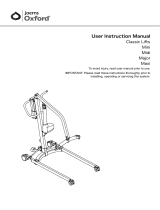
Oxford®
Advance
9
NOTE: Joerns Healthcare recommends:
NEVER reuse circlips.
ALWAYS use circlip pliers for tting.
ENSURE the circlip is properly located in the groove.
Mast/Boom Pivot
1 Check the pivot for lateral, vertical and horizontal play that would indicate excessive wear. Signs of
excessive wear must be investigated and the pivot stripped down. Lateral play at the pivot point must
not exceed 1mm before replacement.
2 Construction of the mast/boom pivot, comprises of 11 components, 2-o M6 x 20mm counter sunk head
screws, 2-o 22mm counter sunk steel caps, 2-o 20mm x 1mm plastic washers, 1-o 10mm inner fulcrum
pin and 1-o 13mm outer sleeve, 2-o 52mm x 2mm plastic pivot bearing washers and 1-o pivot casting.
Removal of the Mast/Boom Pivot
1 To remove the Mast/Boom Pivot it is advisable to rst remove the two M12 bolts from the boom end. This
will enable the pivot to be removed and replaced more easily.
2 The Mast/boom pivot fulcrum pin is held in place with two M6 x 20mm counter sunk head screws.
Remove one of the screws from the fulcrum pin and, leaving the other in place, withdraw the fulcrum pin.
3 Examine the fulcrum pin for signs of wear and for rm attachment of the remaining screw. The
diameter of the fulcrum pin is 10mm. Reduction in diameter due to wear must not exceed 1mm
before replacement.
4 Withdraw the outer sleeve bush from the boom end (hold the boom while doing this as it may fall
forwards). Inspect the sleeve for wear as per the fulcrum pin.
5 Remove the plastic bearing washers (2-o) from the pivot and examine for any wear or damage. Lateral
movement at the pivot is most likely to be caused by wear on these washers.
6 Examine the Mast/Pivot casting, the pivots internal bore and the holes in the mast, in particular, for wear
or damage. The bore and holes are 13mm in diameter; wear should not exceed 1mm on diameter or
2mm elongation before replacement.
Re-Assembling the Mast/Boom Pivot
After performing all the actions and checks in section 4 reassemble the Mast/Boom pivot as follows:
1 Lubricate the fulcrum pin and sleeve with any light mineral-based grease or food grade spray lubricant
paying particular attention to the bearing washers and the mast/boom pivot internal bore.
2 Assemble one end of the fulcrum pin so that the sleeve will t over the pin and rest on the end secured
by the M6 screw after freshly applying thread lock to the thread.
3 Ret the Mast/Boom pivot and one bearing washer into the top of the mast.
4 Align the holes in the mast, bearing washer and Mast/Boom pivot.
5 Insert the sleeved fulcrum pin into the holes and ensure it passes into the boom hole on the opposite side.
6 Pull back the sleeved pin assembly until it is inside the pivot, insert the remaining bearing washer
between the pivot and the inside of the mast. Line up the hole of the washer with the bore of the pivot
and push the sleeved pin assembly through the washer and into the boom.
Replace the remaining cap and washer and M6 screw after freshly applying thread lock to the thread.
NOTE: It is most important the fulcrum pin/sleeve assembly is carefully checked to ensure complete
security. Tighten each screw to 5Nm.
7 Ret the boom end of the Mast/Boom pivot into the boom and ret the 12mm bolts. Ret the M12
Nyloc nuts. (See note below) Tighten each bolt to 15Nm.
8 Replace plastic covers.
























